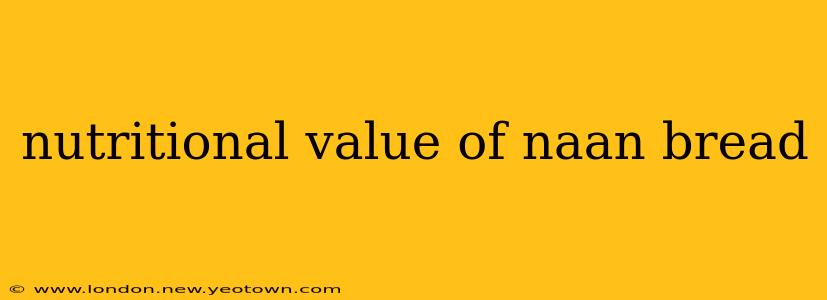Unraveling the Nutritional Value of Naan Bread: A Delicious Deep Dive
Naan, the soft, leavened flatbread, is a staple in many South Asian cuisines. Its slightly chewy texture and subtly sweet flavor make it a perfect accompaniment to curries, kebabs, and even just a simple bowl of dal. But beyond its deliciousness, what's the nutritional story behind this beloved bread? Let's explore the nutritional value of naan bread, addressing some common questions along the way.
What are the main nutrients in naan bread?
Naan, like most breads, is primarily composed of carbohydrates, providing energy. However, the specific nutritional profile can vary significantly depending on the ingredients and preparation method. A typical serving of naan (approximately 100g) generally contains carbohydrates, protein, and a small amount of fat. It's also a source of several essential nutrients, including iron and calcium, although the quantities can be modest compared to other food sources. Many naan recipes include yogurt or milk, boosting its nutritional content further.
Is naan bread healthy?
This is a question that requires a nuanced answer. Naan bread itself isn't inherently "unhealthy," but its nutritional value depends heavily on portion size and preparation. A small serving of naan as part of a balanced meal can be perfectly acceptable. However, it's essential to be mindful of its calorie and carbohydrate content. Many naan variations, especially those made with refined flour, butter, and ghee, are relatively high in calories and saturated fat. These additions boost flavor but significantly increase the caloric density.
How many calories are in a piece of naan bread?
The calorie count in naan bread can fluctuate widely. A small, plain naan might contain around 150-200 calories, while larger, butter-laden versions can easily exceed 300 calories. Therefore, portion control is key if you're watching your calorie intake. Opting for smaller pieces and being aware of the ingredients can help you manage your calorie consumption.
What are the health benefits of eating naan bread?
While not a powerhouse of nutrients, naan bread can contribute to a balanced diet in moderation. Some potential benefits include:
- Energy Source: The carbohydrates in naan provide the body with energy.
- Source of essential nutrients (in moderation): Depending on the recipe, naan can contribute small amounts of iron and calcium.
- Cultural Significance: Naan is an integral part of many cultures' culinary traditions and food heritage, offering valuable social and cultural aspects beyond mere nutrition.
Is naan bread good for weight loss?
Due to its relatively high calorie and carbohydrate content, naan bread isn't typically recommended as a staple in a weight loss diet. However, including a small portion as part of a balanced, calorie-controlled meal plan shouldn't hinder weight loss efforts. Prioritize whole-wheat or multigrain naan options if you choose to include it, as these generally offer more fiber.
What is the difference between naan and roti?
While both are flatbreads, naan and roti differ significantly in their preparation and texture. Naan is leavened (uses yeast), resulting in a soft and airy texture, while roti is unleavened, typically made with whole wheat flour, and possesses a flatter, chewier consistency. Roti is generally considered to be a healthier option due to its lower calorie and fat content and higher fiber.
Ultimately, naan bread, like any food, should be consumed as part of a balanced diet. Enjoy it in moderation, be aware of the ingredients and portion sizes, and prioritize healthier alternatives when possible. Remember, a mindful approach to your diet is key to enjoying your food while maintaining good health.

